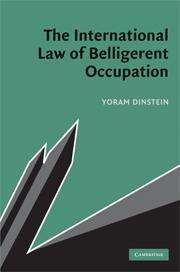Book contents
- Frontmatter
- Contents
- Preface
- Table of cases
- Table of treaties
- Table of UN Resolutions
- List of abbreviations
- 1 The general framework
- 2 The legal nature and basic principles of belligerent occupation
- 3 Human rights and belligerent occupation
- 4 The maintenance of law and order in occupied territories
- 5 Legislation by the Occupying Power
- 6 The judicial system in occupied territories
- 7 Protection of the civilian population under belligerent occupation
- 8 Special protection in occupied territories
- 9 Destruction and pillage of property in occupied territories
- 10 Seizure and use of property in occupied territories
- 11 Other major issues relating to belligerent occupation
- 12 The termination of belligerent occupation
- Conclusion
- Index of persons
- Index of subjects
- References
10 - Seizure and use of property in occupied territories
Published online by Cambridge University Press: 24 January 2011
- Frontmatter
- Contents
- Preface
- Table of cases
- Table of treaties
- Table of UN Resolutions
- List of abbreviations
- 1 The general framework
- 2 The legal nature and basic principles of belligerent occupation
- 3 Human rights and belligerent occupation
- 4 The maintenance of law and order in occupied territories
- 5 Legislation by the Occupying Power
- 6 The judicial system in occupied territories
- 7 Protection of the civilian population under belligerent occupation
- 8 Special protection in occupied territories
- 9 Destruction and pillage of property in occupied territories
- 10 Seizure and use of property in occupied territories
- 11 Other major issues relating to belligerent occupation
- 12 The termination of belligerent occupation
- Conclusion
- Index of persons
- Index of subjects
- References
Summary
General observations
The prohibition of spoliation
497. As formulated by the International Military Tribunal at Nuremberg, the underlying principle regarding seizure and use of property in occupied territories is as follows:
under the rules of war, the economy of an occupied country can only be required to bear the expense[s] of the occupation, and these should not be greater than the economy of the country can reasonably be expected to bear.
In the I.G. Farben trial (part of the ‘Subsequent Proceedings’ at Nuremberg), an American Military Tribunal stated in 1948 that the Nazi occupation had entailed unlawful spoliation of both public and private property in occupied Europe, in a systematic and widespread manner, in total violation of LOIAC. In the Krupp trial, another American Military Tribunal added:
The Articles of the Hague Regulations … are clear and unequivocal. Their essence is: if, as a result of war action, a belligerent occupies territory of the adversary, he does not, thereby, acquire the right to dispose of property in that territory, except according to the strict rules laid down in the Regulations.
The distinction between public and private property
498. The protection accorded to property in occupied territories covers all types of assets found there, but a critical distinction is generally drawn between private and public (or State) ownership, with a preferential treatment granted to private property.
- Type
- Chapter
- Information
- The International Law of Belligerent Occupation , pp. 210 - 237Publisher: Cambridge University PressPrint publication year: 2009



